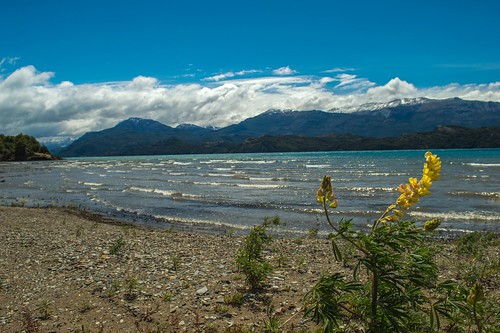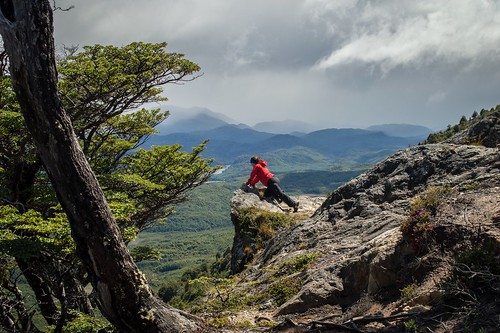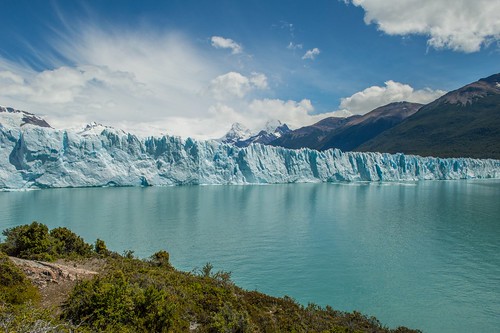We started our trip in Coyhaique (about 1300km from Santiago as the crow flies... or add 900 extra km if you actually want to drive/cycle it!) with a plan of travelling south, all the way to Punta Arenas. The Carretera Austral only runs along the first leg of our planned route, before leaving the stage to relatively untouched and difficult to access wilderness on the Chile side, unless one crosses over to Argentina.
Coyhaique, with almost 54,000 inhabitants, is the biggest hub in the area (meaning it has banks, supermarkets and all sorts of products, including vegetables, and services are available). From Coyhaique, we took a bus to Puerto Rio Tranquilo, which is a quiet little town by the shore of the lake General Carrera (500 inhabitants, no bank, although it has a couple of convenience stores and one of them was quite decent). Finding information about bus time tables and booking yourself some seats is fun (or "nerve racking" if you are new to South America and have not really got into the swing of things, yet). And it only gets "better" as you get closer to the end of that iconic road ;o).
 |
| La Capilla de Mármol |
After a couple of days we moved on to Cochrane (about 3000 inhabitants), where one can find a handful of bars and accommodation, a bank and a supermarket (has most of the basic supplies, though vegetables were scarce). From there buses to further south run increasingly less frequent, with only a couple of departures a week as opposed to daily to Cochrane).
Our last stop in Chile - this is where the road literally ends - was the village of O'Higgins (about 600 inhabitants, no bank, very small stores, make sure you have everything you need with you and plenty of cash). The cabin we found ourselves there was again very cosy and there are a number of interesting treks to tackle from the village, including some that give you view of the nearby glaciers! We hiked up to Mirador La Bandera which gave us some great views of the area and also the whole town (and its incredibly oversized airfield!). Villa O'Higgins was only founded in the 1960's in response to border disputes between Chile and Argentina from the 19th century and up till 1998, and to reinforce Chile's claim to this beautiful part of Patagonia. To this date the village hasn't quite managed to get rid of the somewhat depressing feeling of a military outpost.
 |
| Villa O'Higgins in all it's shine and beauty (airfield at the back) |
In O'Higgins we stayed again two nights and on our last day - the weather started to improve somewhat - we took a boat trip to the O'Higgins glacier. The original idea was to hike there over a period of 4-5 days but due to weather delays we were a bit tight for time so we changed the plan. The glacier was impressive... they are always so beautiful and blue... The cruise was touristy enough and we got to drink some whisky on the rocks with glacier ice (if you know us, you probably know that we enjoyed the ice a lot more than the whisky! ;o)).
 |
| Patricia enjoying the ice (...after chucking most of the Whisky overboard q-;) |
The cruise makes a stop in Cadelario Mancilla (mostly to let walkers and cyclist off as in this place there is only one family and a "Reten de Carabineros", i.e. a police outpost where one can stamp the passport on the way out of Chile), before returning back to Villa O'Higgins. We got off there to start our trek to Argentina. The border is approximately 16 km away but the path (actually rather a gravel road) was very good for trekking (perhaps a little more tricky for cycling) and very picturesque. We got some nice views of Mount Fitzroy and we also saw some woodpeckers (Carpintero Gigante), Hares, Andean Foxes and plenty of birds of prey (more here on flora and fauna).
 |
| Hiking from Candelario Mancilla towards the Argentinian border |
 |
| First glimps of Monte Fitz Roy at the distance |
 |
| Border crossing in the woods |
 |
| Our campsite near the border |
We took a ferry to cross the lake (it conveniently arrived at 11am, just a few minutes after we made it, otherwise it would have taken us an extra 4h of walking - through incredible landscape though!). Once on the other side, we walked for a few kilometers before we managed to hitch a ride down to Hosteria el Pilar which seemed lovely from the outside but for us it was the start of another hour of trekking to the Mirador de Las Piedras Blancas (where one can enjoy a breathtaking view of the Piedras Blancas Glacier).
 |
| Little break to cool down at Mirador de Las Piedras Blancas |
 |
| The X-mas red curry tastes even better after a day of hiking and with a beautiful view |
After a couple of nights on the trail we were fairly hungry campers and ate amazingly (unlike in Chile, the Argentinian Patagonia seems to be more touristy and open to - or at least tolerant of - vegetarianism!). As well as incredible views, El Chalten had a great vibe and for people that are outdoor enthusiasts it is a lot more exciting than the much bigger and touristy town of El Calafate.
Even though it was Christmas day, we had to be efficient as were we only had only 18 hours to prepare (eat lots, sleep lots and sort out logistics) for our next expedition: a trek to the face of the Viedma Glacier and the Huemul Pass (to be able to get some view of the glacier but from the top).
This trek is normally done as a 4-5 day loop (and is supposedly comparable in beauty to the O circuit in Torres del Paine) but as we only had 3 days, we decided to just do the southern section and in the opposite direction as everyone else ;o) The trek was incredible and not that demanding (...except for a river crossing that wasn't to be underestimated).
 |
| Taking the water out of the boots and drying out our gear after the river crossing |
 |
| Throughout the second half of the day we enjoyed amazing views of the glacier |
 |
| View from near our campsite on the first night |
The views from the Huemul pass, which we climbed out to on our second day, were very humbling: one can feel insignificant when presented with such a huge expand of ice and the incredible power of the forces of nature (the wind was strong!). The glacier face views were also amazing, not to mention the hypnotic trance one gets into just chilling by the beach, listening to huge masses of ice cracking and small chunks of ice clinking with the movement of the water... so many things happening in the world while we are "busy" in the office.
 |
| View from the pass on the second day |
 |
| Chilling on the beach after the hike to the pass on the second day |
After 3 days visiting the Viedma Glacier, and to finish the trip, we spent a day in El Calafate and made the required tourist trip to Perito Moreno, which was also impressive and, due to its excellent tourist infrastructure, is well suited for people of all abilities and ages. It was beautiful, perfectly blue/white and very photogenic... certainly not as rugged as Viedma (although the adventure element is also missing and makes for a somewhat less rewarding trip).
Photos of Perito Moreno in below slideshow (or in higher resolution here):
From El Calafate it was only another day on the bus to Puerto Natales (in Chile) and on to Punta Arenas, from where we took a flight back home. Overall, an amazing trip with lots of travelling, hiking and impressive glaciers through a wild part of Patagonia that we hadn't known before.




wow, amazing photos... thanks for sharing. Sharyl Thompson
ReplyDeleteQue maravilloso, gracias por compartir...espero algúnn día poder visitar tan bellos parajes.
ReplyDelete